Longevity Secrets of the Blue Zones

No, it’s not a new miracle herb or weight loss drink from the extraterrestial planet of the Avatars, nor a fancy place on the female physiology. Yet, the Blue Zones are places you’d want to know about, and some are right here in our own backyard.
Identified by National Geographic writer Dan Buettner, along with some of the world’s leading longevity researchers, the Blue Zones are pockets of civilization where people reach the age of 100 ten times more frequently than they do in the U.S. and other parts of the industrialized world.
Furthermore, those who live in Blue Zones enjoy healthier—not just longer—lives; typically living productive, vital lives till well into their 90s. And notably, the leading killers of the industrialized world: heart disease, diabetes, obesity, and cancer occur at only a fraction the rate we’re used to seeing them.
From Sardinia, Italy to Okinawa, Japan, there are a number of communities across the globe whose citizens are enjoying levels of health and longevity that would turn the rest of us green with envy. So far five Blue Zones communities have been identified—Sardinia, Italy; Ikaria, Greece; Nicoya, Costa Rica; Okinawa, Japan, and in the U.S., Loma Linda’s Seventh Day Adventists, which on average enjoy a 10 to 15-year longer life span than people in the rest of the U.S..
So what is it about these Blue Zones that lends their inhabitants longer and more comfortable lives? Many might point to genetics, but research, most notably studies of twins, has established that less than 25% of our life-length is actually determined by our genes. The rest, 75% is determined by lifestyle, or to put it differently, how we treat our bodies: what we eat, how much rest we get, how stressed out we are, how much we move.
Finding the Elusive Fountain of Youth
With the longevity ball batted out of heredity’s court and into our own, the Blue Zones project seeks to take a more proactive approach to how we take care of our long-term health. The premise of the project is simple: if you can find and adopt the common lifestyle factors from the Blue Zones, it should be possible to positively impact anyone’s long-term chances of staying healthy well into old age. In short, you might just have found the elusive formula for the Fountain of Youth.
The Power 9
In his book, the Blue Zones, Dan Buettner summarizes the healthy behaviors shared by the Blue Zones into what he calls The Power 9. Here they are—as you will see, there are some familiar old lifestyle habits, and some new—and surprising—ones..
1. Stop Eating……when you’re 80 percent full.
Using smaller, 10-inch plates can help with this habit, as can serving meals in discrete portions instead of buffet-style.
2. Dine on Plants.
Eat more veggies, and less meat and processed foods. A balance of healthful fats (such as those found in nuts); a variety of vitamins, minerals, and antioxidants; whole grains (quinoa, brown rice, etc.); quality protein (found in beans and lentils); and high-nutrient foods will leave you with stable energy levels and contribute to healthy body weight. Avoid buying junk food, or put it on hard-to-reach shelves, and cook your own meals whenever possible to avoid fast foods.
3. Keep Moving.
Find ways to move naturally, such as walking, gardening, using fewer labor-saving devices. Get a pedometer to keep track of your activity. Many physicians recommend a minimum of 10,000 steps a day. And of course, as any yogi knows, nothing keeps you young like a daily dose of spine-twisting yoga asanas.
4. Slow Down.
Balance work and rest, take vacations regularly, don’t overschedule yourself. In other words, stress less.
5. Drink Red Wine.
People in most Blue Zone communities drank red wine consistently, but in moderation. The antioxidants in wine are powerful disease fighters; if you don’t want to drink wine, organic grape juice or other fresh juices high in antioxidants are a good substitute.
6. Find Purpose.
And pursue it with passion. Having a purpose of life keeps you engaged, vital, and young at heart. Your body will reflect these qualities too.
7. Join a group.
Create a healthy social network. People with strong social support groups are known to live longer and they navigate life’s ups and downs better.
8. Feed your soul.
Engage in spiritual activities, which bring deeper meaning to your life. This doesn’t necessarily mean religious activities, even a walk in nature can be a spiritual activity, as long as it helps broaden your perspective and connect you with the wider cosmos we are a part of.
9. Love your tribe.
Make family and community a high priority.
Of course, changing lifestyle habits isn’t easy, particularly since we daily are bombarded with marketing messages pushing us to consume with abandon stuff which, for the most part, really isn’t that good for us.
However, simply having awareness of what encourages health and what does not is a good start. And as most long-term yoga practitioners experienced, as you deepen your sense of connection with the body through a regular yoga practice, you also deepen your sense of what supports your well-being and what does not. As studies have shown, for example, yoga tends to develop more mindful eating habits, which in turn encourages natural weight loss and keeps the body naturally slim over time.
And that, for most of us, is one thing that will really put us into our own personal Blue Zone.
To find out how long you can expect to live given your current life style habits, try this handy little calculator from the Blue Zones project: The Vitality Compass



